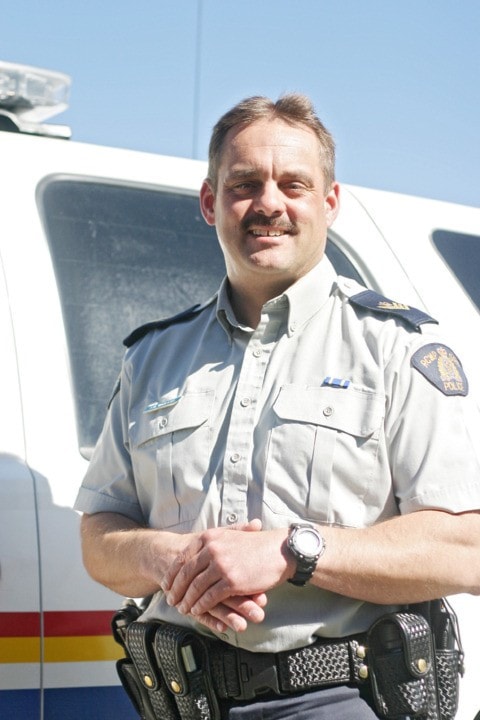RCMP cadets who trained with Sergeant Sean Wadelius got the same question:
"How are your elbows?"
Drill sergeants, who got tired of bloodstains ruining their shirt elbows, knew the answer.
As a defence tactics instructor at the RCMP training depot in Regina, Sgt. Wadelius had a signature drill—making cadets twist across a gym on their bellies, using only their elbows to pull ahead.

That drill, and others like it, earned Wadelius a couple of the gifts from cadets he now keeps in his Houston office: a toy train thats spell P-A-I-N with a matching ball cap that reads "Pain Train Conductor."
Jokes aside, such drills carry a heavy goal.
If an RCMP officer gets shot, they must get to safety, he explains, even if they can't move their arms or legs.
"There's no quitting on me," Wadelius says.
Wadelius added that hard training also shows cadets the kind of effort expected from them in years ahead.
"In our organization, like any other, you have hard rowers and then some that are just along for the ride."
If nothing else, he says, pushing thousands of cadets through the elbows drill gave him the satisfaction of showing any "minimalists" what it's like to carry dead weight.
To judge by his career so far, Wadelius is no easy rider.
In 2008, when he left Regina to lead the Houston/Granisle RCMP, the town was still deeply shaken by the in-custody death of Ian Bush three years before.
No one, it seemed, wanted the Houston post. It went unfilled twice before Wadelius put his name in.
But in key ways, he felt like he'd been prepared for the job.
Growing up in The Pas, a northern Manitoba mill town of 5,500, Wadelius wanted either to fly a jet fighter or join the RCMP.
His math skills made that choice easy.
"Apparently they're not going to trust you with an $80-million plane if you have to use a calculator for everything," he says.
After a B.A. degree in sociology and psychology and two years as a correctional officer, Wadelius got through his own cadet training and onto his first RCMP posting in Prince George.
"It was a frontier—logging, drugs, drinking and fighting," he says. "I spent my formative first five years in that pressure-cooker environment, which was good."
From Prince George, he moved to a post in Fort St. James, then back to Prince George to take on homicides with the North District's Major Crimes Unit.
That post took Wadelius to Houston and across the northwest as he investigated the murder of Deana Lynne-Brane in Quesnel, Highway of Tears cases, a triple murder in Vanderhoof and the murder of Pirkko Skolos in Topley.
After that, and another few years as watch commander of the Terrace drug team, Wadelius felt ready to hit a big goal on his career list—training cadets.
"I looked back at my training days and my crazy self-defence instructor, and I thought that would be something I would really enjoy doing," he says.
But when he got back to depot, now with street experience, Wadelius and other instructors wanted to do more than push cadets hard.
They also wanted to push the RCMP's training model toward more realistic, scenario-based learning.
Back in his day, Wadelius said self-defence training mostly meant a list of isolated skills—karate and jiujitsu, wielding a baton, a Taser, pepper spray or a gun—that were easily forgotten.
Most early learning demos featured a "bad guy" in a padded suit who show some threat, and a cadet would have to handle them one-on-one.
Wadelius turned the model on its head.
In one scenario he wrote, he had a pair of cadets go to make an arrest, which better reflected the reality of the job.
One cadet played a young officer making their first arrest, and Wadelius privately warned them that the suspect, wanted for petty theft, would quickly hurl all kinds of foul language at them.
The other cadet played an older supervisor. Wadelius told them to hang back, and didn't give any heads-up about the suspect.
"This was a social experiment," he says.
It had a striking result.
Time after time, when a "supervisor" saw the younger officer get badmouthed, they lost their cool. Even with a foam training baton, they over-reacted, laying a heavy beating on the bad-mouthed thief.
"In training, they'd never been exposed to that type of thing before," Wadelius said, noting that the scenario was based on a real case, from Terrace.
"You look at power dynamics, the rank structure of the force."
In his time here, Wadelius oversaw an amalgamation with Granisle and major renovations to the Houston detachment building.
Linda Bush was immensely helpful in that effort, he said, by putting pressure on the right people to knock out walls and make other upgrades that allowed video cameras to survey the entire area.
Wadelius also ran a karate club twice a week for his four years here, and recently graduated his first black-belt student.
In the coming weeks, Wadelius will leave Houston for a new post in Chilliwack, where he has a unique chance to push RCMP training another notch.
Now that all working RCMP officers have to get re-certified on defensive tactics every three years, a brand-new facility is going up in Chilliwack for all the B.C. members.
Wadelius will have a leading role in shaping the new training program, and he will also coordinate investigations into cases where the RCMP's use of force comes into question.
Once again, he says he's not expecting an easy start.
"E Division, they always said, marches to the beat of its own drum," he said.
"Well, that's what they're afraid of down south because I'm bringing a new drum, and a new beat."
"Our organization needs leaders," he added.
